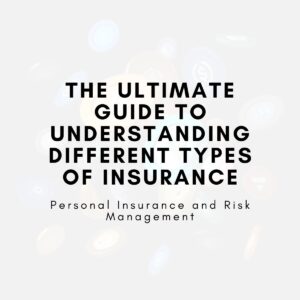
Why is life insurance important, and how can it protect your loved ones?
Life insurance is crucial for ensuring financial security for your loved ones after your passing. It provides financial protection by covering expenses like funeral costs, debts, and ongoing living expenses, easing the financial burden on your family during a difficult time.
Summary Table: Key Insights on Life Insurance
| Section | Summary | Key Tips | Examples |
|---|---|---|---|
| Understanding Life Insurance | Life insurance provides financial support to your family after your death. It can cover funeral costs, debt, and more. | Assess the amount of coverage you need by calculating your family’s financial obligations (mortgage, living expenses, etc.). | Sarah’s $300,000 policy covers her family’s mortgage, living expenses, and children’s education. |
| Why Life Insurance is Crucial? | Life insurance replaces lost income and covers outstanding debts, ensuring financial stability for loved ones. | Consider how much income would need to be replaced and how much debt needs to be covered to decide your coverage amount. | Mark’s policy provides $500,000 to replace his $80,000 salary and cover his family’s daily expenses after his sudden death. |
| Different Types of Life Insurance | There are various types of life insurance including term, whole, universal, and variable life insurance. | Choose the right type based on your goals: term life is affordable, while permanent options offer lifelong coverage and additional benefits like cash value. | Tom chooses a 20-year term policy for affordable premiums; Maria chooses whole life for both coverage and cash value accumulation. |
| How to Choose the Right Policy? | Consider your financial goals and obligations when selecting a life insurance policy. | Compare policy options, assess your financial needs, and consult with professionals to make an informed choice. | Sophie purchases a $700,000 policy after assessing her mortgage, living expenses, and future education costs for her children. |
This table summarizes key insights from the post, outlining how life insurance can be a critical part of financial planning. It breaks down the sections, offering a quick overview of each, key tips for choosing the right coverage, and real-life examples that illustrate the benefits of life insurance in practice. Whether you’re securing your family’s financial future or preparing for unexpected events, this guide helps you make informed decisions about life insurance.
Introduction
Life insurance is often a topic that many people tend to put off, either due to the complexity of the options available or the discomfort in thinking about the inevitable. However, securing life insurance is one of the most responsible financial decisions you can make for your loved ones. Protecting your loved ones financially after your passing is one of the most selfless actions you can take. In this guide, we will explore the importance of life insurance, the different types available, and how to choose the right policy for you. Through real-life examples and actionable advice, you’ll better understand how life insurance ensures your family’s financial security, no matter what happens.
Understanding Life Insurance: A Basic Overview
Life insurance is a financial product designed to provide a monetary benefit to your beneficiaries in the event of your death. In exchange for regular premium payments, your beneficiaries receive a lump-sum payment, also known as the death benefit. The purpose of life insurance is to replace lost income, cover outstanding debts, and manage ongoing living expenses.
What Life Insurance Covers?
Life insurance can cover a wide range of expenses that may be left behind after a person’s death. This includes funeral costs, mortgage payments, credit card debt, and even future educational costs for children. These costs can often be overwhelming for loved ones, and life insurance ensures they aren’t left financially struggling.
Example:
Sarah, a 35-year-old mother of two, has a $300,000 life insurance policy. In case of an unexpected death, this policy would cover funeral expenses, pay off her mortgage, and provide funds for her children’s education. This ensures that her family doesn’t face financial ruin.
How Life Insurance Works?
Upon signing a life insurance policy, you, the policyholder, agree to pay premiums regularly to the insurer. In return, the insurer agrees to pay a death benefit to your designated beneficiaries when you pass away. The amount of coverage, the premiums, and any additional riders or features can vary based on the policy type you choose.
Example:
Tom, a 40-year-old man with a $500,000 policy, pays an annual premium of $600. If Tom unexpectedly passes away, his beneficiaries would receive the $500,000 death benefit to cover immediate expenses such as the mortgage and childcare.
Why Life Insurance is Crucial for Financial Protection?
Life insurance can provide much-needed financial stability during a time of emotional turmoil. Losing a loved one is devastating, but the added stress of navigating financial responsibilities can make it even harder to cope. Life insurance provides peace of mind, knowing your family will have the financial support they need.
Replacing Lost Income
One of the primary reasons people choose life insurance is to replace lost income. If you are the primary breadwinner in your family, your absence could severely impact your loved ones financially. For example, a young family with children might struggle to maintain their standard of living if the main earner passes away. Life insurance can ensure that the surviving spouse doesn’t have to make drastic financial sacrifices.
Example:
Mark is the primary earner in his family, earning $80,000 annually. After purchasing a 20-year term life insurance policy worth $500,000, Mark passes away unexpectedly. The death benefit ensures that his wife and two children will continue living comfortably, with a portion of the funds covering daily living expenses and education.
Covering Debt and Obligations
In addition to replacing income, life insurance can cover outstanding debts such as mortgages, car loans, student loans, or credit card debt. Imagine a scenario where a person passes away unexpectedly, leaving behind significant financial obligations. Without life insurance, the burden of these debts may fall entirely on the surviving spouse or family members, potentially leading to financial hardship.
Example:
Jessica, a single woman, has a $150,000 mortgage and $10,000 in credit card debt. She purchases a life insurance policy with a $200,000 death benefit. If Jessica passes away, the policy will cover the mortgage and credit card debt, so her family is not left with these financial obligations.
Protecting Your Children’s Future
For parents, life insurance offers a way to safeguard their children’s future. A life insurance policy can help cover the costs of their children’s education, ensuring that they are not deprived of opportunities in case something happens to the parents. Consider a single parent who has a child preparing to attend college—life insurance can ensure that their child’s education is taken care of, regardless of the parent’s passing.
Example:
Laura, a single mother, purchases a whole life insurance policy with a $300,000 death benefit to provide for her child’s future education. After she unexpectedly passes away, the policy ensures that her 16-year-old daughter’s college tuition is paid for, easing the financial burden on her extended family.
Different Types of Life Insurance Policies
When it comes to life insurance, there are several different types to choose from. The best policy for you will depend on your specific financial needs, goals, and preferences.
Term Life Insurance
Term life insurance is one of the most common types of life insurance. It provides coverage for a fixed period (usually 10, 20, or 30 years) and pays out a death benefit if you pass away during the term. Term life insurance is generally more affordable than permanent life insurance, making it a great option for young families or those on a tight budget.
Example:
Chris, aged 30, purchases a 20-year term life insurance policy worth $400,000 for an annual premium of $350. If Chris dies before age 50, his family will receive the full $400,000 death benefit to cover living expenses and pay off any outstanding debts.
Whole Life Insurance
Whole life insurance offers lifetime coverage, as long as you continue to pay premiums. In addition to the death benefit, it also includes a cash value component that grows over time. While whole life insurance tends to have higher premiums, it can serve as both insurance protection and a financial asset.
Example:
Maria purchases a whole life insurance policy with a $500,000 death benefit, which also accumulates cash value over time. By the time Maria turns 60, the policy has accumulated $100,000 in cash value, which she can borrow from for retirement or emergencies.
Universal Life Insurance
Universal life insurance is another type of permanent life insurance that combines a death benefit with a savings component. Unlike whole life insurance, universal life policies offer more flexibility, allowing you to adjust the coverage amount and premiums as your needs change.
Example:
Rob purchases a universal life insurance policy with a $1,000,000 death benefit. The policy allows him to adjust the premiums as his financial situation changes. In the future, Rob can reduce or increase coverage or borrow from the cash value as needed.
Variable Life Insurance
Variable life insurance is a type of permanent life insurance that allows you to invest your premiums in various investment options such as stocks and bonds. The death benefit and cash value can fluctuate based on the performance of these investments, making it a more dynamic choice for those seeking potential growth.
Example:
Linda opts for a variable life insurance policy with a $500,000 death benefit. She allocates her premiums toward stock market investments, and after 10 years, the cash value of her policy grows to $200,000 due to the strong performance of her chosen investments.
How to Choose the Right Life Insurance Policy?
Choosing the right life insurance policy is a personal decision and should be based on your financial goals, lifestyle, and budget.
Assessing Your Financial Needs
To determine how much life insurance you need, start by assessing your financial obligations. Consider factors such as mortgage payments, childcare costs, outstanding debts, and any future expenses (such as education costs). This will help you determine the appropriate coverage amount.
Example:
Sophie, a 40-year-old with two children, calculates that her family’s total monthly expenses are $4,000, which includes mortgage payments, utilities, and groceries. To determine the coverage amount, Sophie multiplies this by 12 (months) and adds any additional obligations, coming to a total of $700,000. She purchases a life insurance policy with this coverage amount.
Comparing Policies
Once you know how much coverage you need, compare different policies from various insurers. Look for plans with competitive premiums and benefits, and make sure to review any exclusions or limitations carefully.
Example:
After receiving multiple quotes for life insurance, Mark compares the terms of different providers. He chooses a policy with affordable premiums but also checks for exclusions like coverage for pre-existing conditions to ensure the policy fits his needs.
Seeking Professional Advice
Choosing a life insurance policy can be overwhelming, and it might be worth consulting with a financial advisor or insurance expert to ensure you’re making the right choice. An advisor can help you navigate different policy options and select one that fits your long-term financial goals.
Example:
David decides to meet with a financial planner to discuss his life insurance needs. The planner helps him evaluate his goals and recommends a balanced mix of term life and permanent life insurance to cover his family’s needs for both short-term and long-term security.
Real-Life Examples of Life Insurance Benefiting Families
Understanding the real-world implications of life insurance can help underscore its importance.
Example 1: Protecting a Young Family
Sarah and Tom, both in their early 30s, have two young children. Tom is the primary earner in the family, making $75,000 annually. They decide to purchase a 20-year term life insurance policy with a $500,000 death benefit. Tragically, Tom passes away unexpectedly, and Sarah is left with the financial burden of maintaining the household and raising their children. Fortunately, the life insurance policy pays out, allowing Sarah to cover funeral expenses, pay the mortgage, and ensure the children’s education is funded.
Example 2: Covering a Mortgage
James, a 45-year-old single man, has a mortgage worth $250,000. He chooses a 15-year term life insurance policy with a $300,000 death benefit to ensure that, if something happens to him, his family can pay off the mortgage. A few years later, James passes away suddenly, and his family uses the death benefit to pay off the mortgage, preventing them from losing their home.
Example 3: Ensuring College Education
Emily, a single mother of two, has an 18-year-old daughter preparing to attend college. She buys a whole life insurance policy worth $400,000 with a cash value accumulation feature. When Emily unexpectedly passes away, the policy ensures that her daughter’s college tuition is fully covered, relieving her family from the financial burden of educational expenses.
Conclusion
Life insurance is an invaluable financial tool that can provide peace of mind and ensure the well-being of your loved ones after you’re gone. Whether you’re replacing lost income, covering debt, or securing your children’s future, life insurance offers a safety net that can help navigate the most challenging times. By carefully assessing your needs, understanding your options, and seeking professional advice, you can choose the right life insurance policy to safeguard your family’s financial security.
Takeaways:
- Life insurance provides financial protection for your loved ones in the event of your death.
- It can cover expenses like funeral costs, mortgages, and future education.
- There are different types of life insurance policies, including term, whole, universal, and variable life insurance.
- Assess your financial needs before selecting a life insurance policy, and compare various options.
- Real-life examples demonstrate the vital role life insurance plays in securing a family’s future.




